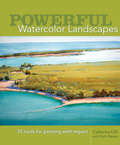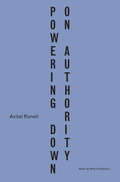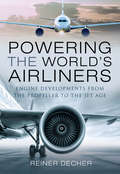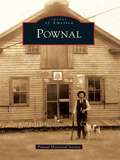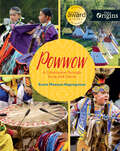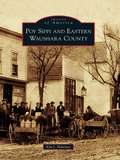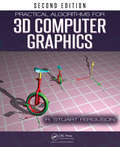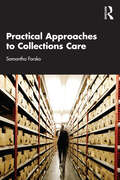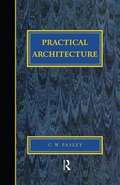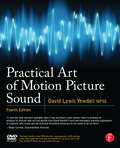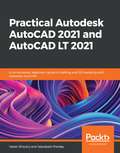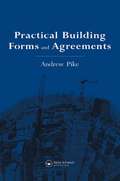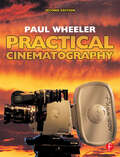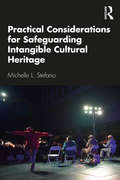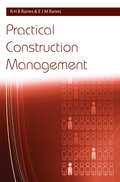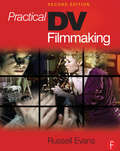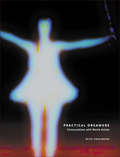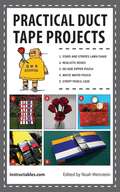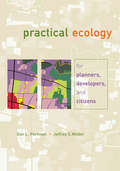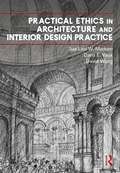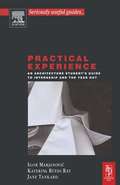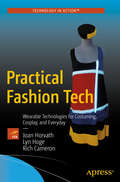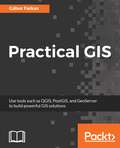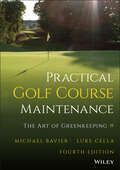- Table View
- List View
Powerful Watercolor Landscapes: Tools for Painting with Impact
by Catherine GillBanish boring watercolors forever! This guide gives you the "power tools" you need to transform dull, flat landscapes into robust, colorful expressions of your artistic vision. Each chapter focuses on a specific strategy for tackling tough challenges, complete with inspiring examples, hands-on demonstrations and instructional diagrams to make these strategies easy and fun to learn. Following this guide's masterful visual instruction, you'll learn how to: • See beyond "what you see" to develop strong foundations in every composition • Avoid repainting, overworking and frustration by focusing on a composition's unifying elements • Become decisive with your values for heightened interest and impact • Quickly and easily mix a huge range of clean, rich colors-including vibrant grays and greens-with no more mud! • Put it all together following detailed step-by-step demonstrations of complete paintings from start to finish Whether you're new to watercolor painting or not, this guide will empower you to push shape and color into exciting new territory. Experience the satisfaction of painting with "power tools" and enjoy immediate results in your work.
Powering Down On Authority (English and Dutch)
by Monika Szewczyk Avital Ronell Vincent W.J. van Gerven OeiPowering Down on Authority is Avital Ronell's response to Witte de With's invitation for her to reflect, in lengthy essay form, on the questions of power and authority in our time.
Powering the World's Airliners: Engine Developments from the Propeller to the Jet Age
by Reiner DecherFrom propellers to turbofans, this illustrated history of engines will be “of interest to modelers and aviation historians alike” (AMPS Indianapolis).The first efforts of man to fly were limited by his ability to generate sufficient power to lift a heavier-than-air machine off the ground. Propulsion and thrust have therefore been the most fundamental elements in the development of aircraft engines.From the simple propellers of the first airliners of the 1920s and 1930s, to the turboprops and turbojets of the modern era, the engines used in airliners have undergone dramatic development over a century of remarkable change. These advances are examined in detail by aeronautical engineer Reiner Decher, who provides a layman’s guide to the engines that have, and continue to, power the aircraft that carry millions of travelers across millions of miles each year. Decher also looks at the development of aero engines during the Second World War and how that conflict drove innovation and explains the nature of wing design, from the early twentieth century to the present.To enable an easy understanding of this intriguing subject, Powering the World’s Airliners is profusely illustrated, transporting readers back to the time of each major development and introducing them to the key individuals of the aero industry in each era. After reading this comprehensive yet engaging story of the machines that power the aircraft in which we fly, no journey will ever seem quite the same again.
Pownal (Images of America)
by Pownal Historical SocietyIn the 1700s, the fertile valley lands and wooded hills of Pownal attracted Dutch tenant farmers and English settlers. French Canadians soon arrived in the villages of Pownal to work in the mills, as both adults and children. Later painters and magazines captured the beauty of the land, while hill farmers struggled to make the thin soil produce. Following World War II, a United Nations magazine featured Pownal on its cover as a symbol of the peace so many sought. The photographs in Pownal illustrate the beauty, as well as hardships, associated with rural life. Vintage images of barefooted school students, farmers working their horses, and proud owners of the first automobiles capture the hardworking people of this Vermont community living amid a beauty that tourists seek.
Powwow: A Celebration through Song and Dance (Orca Origins #7)
by Karen Pheasant-Neganigwane★ “Clearly organized and educational—an incredibly useful tool for both school and public libraries.” —School Library Journal, starred review Powwow is a celebration of Indigenous song and dance. Journey through the history of powwow culture in North America, from its origins to the thriving powwow culture of today. As a lifelong competitive powwow dancer, Karen Pheasant-Neganigwane is a guide to the protocols, regalia, songs, dances and even food you can find at powwows from coast to coast, as well as the important role they play in Indigenous culture and reconciliation. The epub edition of this title is fully accessible.
Poy Sippi and Eastern Waushara County
by Kim J. HeltemesIn the early stages of Wisconsin's statehood, Vermonters settled in an area in east-central Wisconsin. Poy Sippi is a fine example of the pioneers' thirst for adventure, exploration, and hard work ethic. The lakes, creeks, and swamps did not impede this thirst. A small town nestled between two hills, Poy Sippi reminded the settlers of their eastern homes. The interaction of families within the neighboring communities brought about strong bonds and the development of eastern Waushara County. This is their story, told through vintage photographs.
Practical Algorithms for 3D Computer Graphics
by R. Stuart FergusonPractical Algorithms for 3D Computer Graphics, Second Edition covers the fundamental algorithms that are the core of all 3D computer graphics software packages. Using Core OpenGL and OpenGL ES, the book enables you to create a complete suite of programs for 3D computer animation, modeling, and image synthesis.Since the publication of the first edit
Practical Approaches to Collections Care
by Samantha ForskoWhile cultural heritage practitioners and caretakers are often intimidated by "best practices," Practical Approaches to Collections Care helps to alleviate those concerns, offering a stepped approach to preservation encompassing a variety of collections care programs. The author, drawing on over a decade of experience working in libraries, museums, archives, and other historic sites, and specifically building off of her work as a Preservation Specialist at the Conservation Center for Art & Historic Artifacts, discusses realistic, efficient, and sustainable approaches to collection housing, space planning, environmental management, facilities care, emergency preparedness, and much more. Giving examples of implementation and easy-to-follow guides that will allow readers to start from scratch or improve an already existing program, Forsko demonstrates how preservation can become a component of any collections care program. Encouraging the reader to start by taking small, manageable steps, the author shows that even the smallest of actions can make a difference that will ultimately help to preserve collections and ensure that the world’s heritage will remain intact for future generations. Practical Approaches to Collections Care takes an applied approach, making suggestions the reader can immediately implement no matter the size of their institution. It is an essential tool for stewards of cultural heritage collections, particularly collections managers, registrars, and preservation specialists. It will also be useful to students who are engaged in the study of collections care.
Practical Architecture: Brickwork, Mortars and Limes
by Cw PasleyPasley's work was first written in 1826 as a course of architecture for his students at the Royal Engineer's School in Chatham. The original title of the book, "Outline of a Course of Practical Architecture" is therefore a little misleading to the modern reader as the course was primarily concerned with building construction, concentrating on all aspects of brickwork. Major General Sir C.W. Pasley, K.C.B wanted his students to be in a position to construct, maintain and extend all different types of ordinary brick buildings such as barracks, hospitals and store-houses. But whilst his interest was primarily military structures, the construction techniques were also equally applicable to civil buildings. This book, therefore, provides interesting and useful information on how buildings were being constructed a hundred and fifty years ago, and the type of limes and cements that were used. In addition to the material on mortars and cements, it examines in detail the bonds in brickwork and provides full coverage of different types of arches and how they are formed. It also explains the specific aspects relating to the construction of hollow or double walls; copings; chimneys and chimney breasts; gateways; and, brick ornamentation and so on. "Practical Architecture" will be of interest to architects, surveyors and structural engineers and all those involved in the repair and conservation of brick structures.
Practical Art of Motion Picture Sound: Professional Techniques Of Motion Picture And Television Audio
by David Lewis YewdallPractical Art of Motion Picture Sound, 4th edition relies on the professional experience of the author and other top sound craftspeople to provide a comprehensive explanation of film sound, including mixing, dubbing, workflow, budgeting, and digital audio techniques.
Practical Autodesk AutoCAD 2021 and AutoCAD LT 2021: A no-nonsense, beginner's guide to drafting and 3D modeling with Autodesk AutoCAD
by Yasser Shoukry Jaiprakash PandeyLearn 2D drawing and 3D modeling from scratch using AutoCAD 2021 and its more affordable LT version to become a CAD professional Key Features Explore the AutoCAD GUI, file format, and drawing tools to get started with CAD projects Learn to use drawing management tools for working efficiently on large projects Discover techniques for creating, modifying, and managing 3D models and converting 2D plans into 3D models Book Description AutoCAD and AutoCAD LT are one of the most versatile software applications for architectural and engineering designs and the most popular computer-aided design (CAD) platform for 2D drafting and 3D modeling. This hands-on guide will take you through everything you need to know to make the most out of this powerful tool, starting from a simple tour of the user interface through to using advanced tools. Starting with basic drawing shapes and functions, you'll get to grips with the fundamentals of CAD designs. You'll then learn about effective drawing management using layers, dynamic blocks, and groups and discover how to add annotations and plot like professionals. The book delves into 3D modeling and helps you convert your 2D drawings into 3D models and shapes. As you progress, you'll cover advanced tools and features such as isometric drawings, drawing utilities for managing and recovering complex files, quantity surveying, and multidisciplinary drawing files using xRefs, and you'll learn how to implement them with the help of practical exercises at the end of each chapter. Finally, you'll get to grips with rendering and visualizing your designs in AutoCAD. By the end of the book, you'll have developed a solid understanding of CAD principles and be able to work with AutoCAD software confidently to build impressive 2D and 3D drawings. What you will learn Understand CAD fundamentals using AutoCAD's basic functions, navigation, and components Create complex 3d solid objects starting from the primitive shapes using the solid editing tools Working with reusable objects like Blocks and collaborating using xRef Explore some advanced features like external references and dynamic block Get to grips with surface and mesh modeling tools such as Fillet, Trim, and Extend Use the paper space layout in AutoCAD for creating professional plots for 2D and 3D models Convert your 2D drawings into 3D models Who this book is for The book is for design engineers, mechanical engineers, architects, and anyone working in construction, manufacturing, or similar fields. Whether you're an absolute beginner, student, or professional looking to upgrade your engineering design skills, you'll find this AutoCAD book useful. No prior knowledge of CAD or AutoCAD is necessary.
Practical Autodesk AutoCAD 2023 and AutoCAD LT 2023: A beginner's guide to 2D drafting and 3D modeling with Autodesk AutoCAD, 2nd Edition
by Yasser Shoukry Jaiprakash PandeyLearn 2D drawing and 3D modeling from scratch using AutoCAD and AutoCAD LT 2023 and become a CAD professionalKey FeaturesLearn techniques for making, modifying, and managing AutoCAD 2D and 3D drawingsUnderstand how to use reusable and named objects like blocks, xRef, and layersScale, annotate, and print drawings from model space and layoutBook DescriptionAutoCAD is one of the most versatile software applications for architectural and engineering designs and the most popular computer-aided design (CAD) platform for 2D drafting and 3D modeling. This hands-on 2nd edition guide will take you through everything you need to know to make the most out of this powerful tool, from a simple tour of the user interface to using advanced tools.Starting with basic drawing shapes and functions, you'll get to grips with the fundamentals of CAD designs. You'll then learn about effective drawing management using layers, dynamic blocks, and groups, and discover how to add annotations and plots like a professional. As you progress, the book will show you how to convert your 2D drawings into 3D models and shapes. You'll also discover advanced features, such as isometric drawings, drawing utilities for managing and recovering complex files, quantity surveying, and multidisciplinary drawing files using xRefs. Finally, you'll focus on rendering and visualizing your designs in AutoCAD.By the end of this book, you'll have developed a solid understanding of CAD principles and be able to work with AutoCAD software confidently to build impressive 2D and 3D creations.What you will learnUnderstand CAD fundamentals like functions, navigation, and componentsCreate complex 3D objects using primitive shapes and editing toolsWork with reusable objects like blocks and collaborate using xRefExplore advanced features like external references and dynamic blocksDiscover surface and mesh modeling tools such as Fillet, Trim, and ExtendUse the paper space layout to create plots for 2D and 3D modelsConvert your 2D drawings into 3D modelsWho this book is forThis 3D modeling book is for design engineers, mechanical engineers, architects, and anyone working in construction, manufacturing, or similar fields. Whether you're an absolute beginner, student, or professional looking to upgrade your engineering design skills, you'll find this AutoCAD book useful. No prior knowledge of CAD or AutoCAD is necessary.
Practical Building Forms and Agreements
by Andrew Pike A. PikeThe purpose of this book is to help employers and their advisers (especially their Quantity Surveyors) in drawing up all the contracts required on a normal UK building project.
Practical Cinematography
by Paul WheelerFilmmaking is an art, but, like so many art forms, there are basic underlying tools and techniques and a body theoretical knowledge that must be understood and mastered before artistic expression can flourish. This book is an invaluable resource for all aspiring DoPs. Practical Cinematography can be dipped into for quick reference - perhaps to answer a specific question or deal with practical problems relating to a shoot - or read from cover to cover. It discusses the principles of cinematography and the expertise which is unique to the Director of Photography (DoP). It deals with all the basic theory such as color temperature and sensitometry, and all the practical things a DoP needs to know, from the make-up of the crew to how to prepare an equipment list.
Practical Considerations for Safeguarding Intangible Cultural Heritage
by Michelle L. StefanoPractical Considerations for Safeguarding Intangible Cultural Heritage examines theoretical issues relating to intangible cultural heritage policy and practice, whilst also proposing practical ways to facilitate the safeguarding of such heritage. Providing guidelines for best practice that take into account the constraints of the UNESCO-ICH paradigm, Stefano examines the principles and practices of two alternative and largely non-UNESCO frameworks for sustaining living cultural traditions: the philosophy of ecomuseology, and the discipline of public folklore in the context of the U.S. Arguing that they offer more collaborative, equitable, and effective ways forward for safeguarding ICH, Stefano demonstrates how they can address the limitations of the UNESCO-ICH paradigm. Importantly, the book offers a personal perspective, grounded in the author’s public sector work, which allows the ICH discourse to move beyond critical analysis and explore realistic, alternative ways in which ICH can be collaboratively and equitably safeguarded. Practical Considerations for Safeguarding Intangible Cultural Heritage proposes guidelines for professionals, researchers, and communities that foster safeguarding approaches that are as unique and nuanced as ICH expressions themselves. The interdisciplinary nature of the book will ensure that it is useful to those interested in community-led ICH safeguarding, as well as the impacts of UNESCO’s 2003 Convention, in diverse geographic, political, economic, and sociocultural contexts.
Practical Construction Management
by R. H. Ranns E. J. RannsFilled with practical advice for all aspects of the construction manager's role, this invaluable book fills a need for training in this essential subject, to ensure greater efficiency on site and smoother client-contractor relations. Developed as a handy-reference guide for practitioners and also useful for students, it covers the broad range of responsibilities associated with the role, providing clear guidance and in-depth coverage of the essentials. Topics include financial responsibilities and how to handle them, tender preparation, people management, health and safety, contracts, subcontracting, measurement and quantities, insurance and risk and many more simple and effective methods for turning construction projects into reality.
Practical DV Filmmaking
by Russell EvansWritten for the beginner, Practical DV Filmmaking guides you thorough the process of making a film with low-cost digital equipment: from development through to production, post-production and distribution. While the technical tools you need are fully explained, the book concentrates on filmmaking principles throughout, illustrating how these tools can be used to achieve stylistic approaches for innovative filmmaking.The book assumes no background knowledge in either technology or filmmaking and is divided into four key areas:*DEVELOPMENT: turn your idea into a workable script, storyboard and schedule.*PRODUCTION: develop skills to shoot original short films and turn a zero-to-low budget to your advantage.*POST-PRODUCTION: learn basic editing techniques to enhance your original idea using iMovie, Premiere and other popular tools.*DISTRIBUTION: set up a website and use the internet to promote your film. Includes numerous links to useful websites. Plus, top tips for how to enter a film festival and a new chapter on developing a career.Projects enable you to master each step of the process taking you through different aspects of filmmaking today. Gradually you will find out where your strengths lie and how to make the most of them. The book also encourages stylistic development by intruding theoretical approaches to filmmaking. A glossary of terms plus an appendix of resources make this guide a one-stop essential handbook to DV filmmaking practice for beginners and student filmmakers.
Practical Dreamers: Conversations with Movie Artists
by Mike Hoolboom'The streets are full of admirable craftsmen, but so few practical dreamers.' Man Ray What if there were movies made th same way as suits, custom fitted, each one tailored for one person? Not broadcast, but narrowcast? Not theatres around the world showing the same globalized pictures, but instead a local circumstance, a movie so particular, so peculiar, it could cure night blindness or vertigo? Welcome to the world of fringe movies, where artists have been busy putting queer shoulders to the wheels, or bending light to talk about First Nations rights (and making it funny at the same time), or demonstrating how a personality can be taken apart and put together again, all in the course of a ten-minute movie which might take years to make. Practical Dreamers takes us to this other side of the media plantation. In it, twenty-seven Canadian artists dish about how they get it done and why it matters. The conversations are personal, up close and jargon free, smart without smarting. The stellar cast includes smartbomb Steve Reinke; visionary Peter Mettler; Middle East specialist Jayce Salloum; queer Asian avatars Richard Fung, Midi Onodera, Ho Tam, and Wayne Yung; footage recyclers Aleesa Cohene and Jubal Brown; overhead projector king Daniel Barrow; First Nations vets Kent Monkman and Shelley Niro; international art presence Paulette Phillips; and documentarian Donigan Cumming. These in-depth talks come lavishly illustrated in an oversized volume.
Practical Duct Tape Projects
by Instructables. Com Noah WeinsteinDuct tape has gotten a reputation as the quick-fix tape for every situation. However, did you know that you can use duct tape to create practical items for everyday use? Did you also know that duct tape now comes in a variety of colors, so your creations can be fun and stylish? Originating from Instructables, a popular project-based community made up of all sorts of characters with wacky hobbies and a desire to pass on their wisdom to others, Practical Duct Tape Projects contains ideas from a number of authors who nurse a healthy urge to create anything possible from duct tape.Practical Duct Tape Projects provides step-by-step instructions on a variety of useful and fun objects involving duct tape. Guided through each endeavor by detailed photographs, the reader will create articles of clothing, tools, and more, such as:Fishing netMessenger bagWallet with change pouchDuck tub stopperLaptop casePencil caseAnd much more!The Instructables community has provided a compilation of guides on a variety of duct tape exploits. The most outrageous projects are definitely the most fun, and this book shows that duct tape can make just about anything.
Practical Ecology for Planners, Developers, and Citizens
by Dan L. Perlman Jeffrey MilderPractical Ecology for Planners, Developers, and Citizens introduces and explains key ecological concepts for planners, landscape architects, developers, and others involved in planning and building human habitats. The book is tailored to meet the needs of busy land use professionals and citizens seeking a concise yet thorough overview of ecology and its applications. It offers clear guidelines and a wealth of information on how we can protect species and ecosystems while at the same creating healthy, sustainable human communities. Throughout the book, the authors make ecological concepts accessible to readers with little or no scientific background. They present key ideas and information in simple and pragmatic terms, and provide numerous graphics to help explain important concepts. They also offer exercises for the reader to practice ecologically-based planning and design, along with a list of resources for practical information on ecology and conservation. Practical Ecology for Planners, Developers, and Citizens will raise the level of ecological understanding among land use professionals and citizens, and is an invaluable new resource for anyone concerned with human land use and its environmental impacts.
Practical Ethics in Architecture and Interior Design Practice
by David Wang Dana E. Vaux Sue Lani MadsenPractical Ethics in Architecture and Interior Design Practice presents the basics of design practice through ethical scenarios, ushering design students into real-world experiential learning. Each chapter begins with a detailed story involving a complicated set of practical and ethical dilemmas, exemplifying those encountered each day in the world of professional practice. Practice-based topics such as contracts and project delivery methods, marketing design services, cross-cultural collaboration, virtual connectivity, social justice and sustainable design, soft skills, and other related professional practice themes are anchored in realistic scenarios. While all the stories are fictional, in writing them the authors drew from over seventy-five combined years of professional experience in architecture and interior design as well as many years of academic experience in teaching professional practice and ethics to architecture and interior design students. Each story is followed by discussion questions and suggested additional resources. This book provides a unique integrated perspective into the allied fields of architecture and interior design with topics relevant to both fields as well as specific to each profession. It prepares students of both disciplines for the broad issues of professional practice and encourages them to become ethical practitioners ready to contribute effectively to design teams and to ask the right questions.
Practical Experience: An Architecture Student's Guide To Internship And The Year Out
by Katerina Ruedi Ray Jane TankardThe year out, or internship, in a professional practice can be the most rewarding experience in an architectural student's education. It can also be a shock to the system to find that architectural working practices are very different to architectural study. This book provides a beginner's guide to professional practice and a step-by-step guide on how to find the placement that best suits your goals. It is the fourth title in the successful 'Seriously Useful Guides...' series.In order to give you a real insight into professional experience, this guide includes reallife case studies from students who have been through the experience and from practices that have taken them on. It guides you through the steps of finding a placement, outlines the norms and expectations for internship in different countries, and discusses codes of office behavior and professional ethics. Contemporary architecturalpractices are becoming increasingly diverse and this guide outlines some Practical experience/Internship choices, providing cases studies of award wining firms that offer practical experience. These case studies range from conventional practices based on the art of building, to practices based on digital media or contemporary urbanism. Finally, the term 'critical practice' is becoming increasingly important, and the book provides some definitions and examples of critically based architectural practices.Also in the Seriously Useful Guides Series:* The Crit* The The Portfolio* The Dissertation
Practical Fashion Tech
by Joan Horvath Rich Cameron Lyn HogePull back the curtain on making fun and innovative costumes and accessories incorporating technologies like low-cost microprocessors, sensors and programmable LEDs. Fashion tech can require skills in design, pattern-making, sewing, electronics, and maybe 3D printing. Besides the tech skills, making a good costume or accessory also requires knowledge of the intangibles of what makes a good costume. This book is a collaboration between two technologists and a veteran teacher, costumer, and choreographer. Regardless of whether you are coming at this from the theater costuming, sewing, or electronics side, the authors will help you get started with the other skills you need. More than just a book of projects (although it has those too), Practical Fashion Tech teaches why things are done a certain way to impart the authors' collective wealth of experience. Whether you need a book for a wearable tech class or you just want to get started making fantastic costumes and wearables on your own, Practical Fashion Tech will get you there. What you will learn: The fundamentals of both the sewing and the technology aspects of wearable tech for fashion How to make a memorable costume that reacts to its wearer or environment Ideas for using this book as a textbook Who this is for: Electronics enthusiasts, hipsters, costume designers, teachers, and students who want to learn how to make fashion or cosplay weara bles. Cosplay fans wanting to incorporate sensors and more into their costumes.
Practical GIS
by Gabor FarkasLearn the basics of Geographic Information Systems by solving real-world problems with powerful open source tools About This Book • This easy-to-follow guide allows you to manage and analyze geographic data with ease using open source tools • Publish your geographical data online • Learn the basics of geoinformatics in a practical way by solving problems Who This Book Is For The book is for IT professionals who have little or no knowledge of GIS. It's also useful for those who are new to the GIS field who don't want to spend a lot of money buying licenses of commercial tools and training. What You Will Learn • Collect GIS data for your needs • Store the data in a PostGIS database • Exploit the data using the power of the GIS queries • Analyze the data with basic and more advanced GIS tools • Publish your data and share it with others • Build a web map with your published data In Detail The most commonly used GIS tools automate tasks that were historically done manually—compiling new maps by overlaying one on top of the other or physically cutting maps into pieces representing specific study areas, changing their projection, and getting meaningful results from the various layers by applying mathematical functions and operations. This book is an easy-to-follow guide to use the most matured open source GIS tools for these tasks. We'll start by setting up the environment for the tools we use in the book. Then you will learn how to work with QGIS in order to generate useful spatial data. You will get to know the basics of queries, data management, and geoprocessing. After that, you will start to practice your knowledge on real-world examples. We will solve various types of geospatial analyses with various methods. We will start with basic GIS problems by imitating the work of an enthusiastic real estate agent, and continue with more advanced, but typical tasks by solving a decision problem. Finally, you will find out how to publish your data (and results) on the web. We will publish our data with QGIS Server and GeoServer, and create a basic web map with the API of the lightweight Leaflet web mapping library. Style and approach The book guides you step by step through each of the core concepts of the GIS toolkit, building an overall picture of its capabilities. This guide approaches the topic systematically, allowing you to build upon what you learned in previous chapters. By the end of this book, you'll have an understanding of the aspects of building a GIS system and will be able to take that knowledge with you to whatever project calls for it.
Practical Golf Course Maintenance: The Art of Greenkeeping
by Michael Bavier Luke CellaA Practical Step-by-Step Guide to Maintaining and Operating a Golf Course From the fairway to the flagsticks, operating a golf course presents a variety of challenges. To maintain a beautiful course and ensure smooth day-to-day operations, one must possess a strong foundation of knowledge across many different fields. Practical Golf Course Maintenance, Fourth Edition assists golf industry professionals with every component of course management so that players have the best experience possible. As seasoned golf industry professionals, the two authors have years of hands-on experience in the field solving problems relating to every facet of running a modern golf course. This fourth edition contains new and updated advice and guidelines for running a golf course, including: A new chapter offering guidance for superintendents to work with club officials and green committee members to achieve success in their challenging roles Rule changes from the USGA and R&A and how they affect maintenance strategies Discussions of current and future course technologies, including robotic mowers, drones, and advanced irrigation systems An overview of the evolving job descriptions and responsibilities of key positions in the field A common sense approach to the art of greenkeepingPractical Golf Course Maintenance, Fourth Edition has been purposefully written to provide useful information to both the untrained and experienced greenkeeping professional. It serves as a thorough introduction of golf course maintenance to anyone interested in the profession, including course or club officials and managers, green committee members, and anyone who has a vested interest in understanding what it takes to run a golf course.
